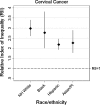Does socioeconomic disparity in cancer incidence vary across racial/ethnic groups?
- PMID: 20567897
- PMCID: PMC2941051
- DOI: 10.1007/s10552-010-9601-y
Does socioeconomic disparity in cancer incidence vary across racial/ethnic groups?
Abstract
Objective: Very few studies have simultaneously examined incidence of the leading cancers in relation to socioeconomic status (SES) and race/ethnicity in populations including Hispanics and Asians. This study aims to describe SES disparity in cancer incidence within each of four major racial/ethnic groups (non-Hispanic white, black, Hispanic, and Asian/Pacific Islander) for five major cancer sites, including female breast cancer, colorectal cancer, cervical cancer, lung cancer, and prostate cancer.
Methods: Invasive cancers of the five major sites diagnosed from 1998 to 2002 (n = 376,158) in California were included in the study. Composite area-based SES measures were used to quantify SES level and to calculate cancer incidence rates stratified by SES. Relative index of inequality (RII) was generated to measure SES gradient of cancer incidence within each racial/ethnic group.
Results: Significant variations were detected in SES disparities across the racial/ethnic groups for all five major cancer sites. Female breast cancer and prostate cancer incidence increased with increased SES in all groups, with the trend strongest among Hispanics. Incidence of cervical cancer increased with decreased SES, with the largest gradient among non-Hispanic white women. Lung cancer incidence increased with decreased SES with the exception of Hispanic men and women, for whom SES gradient was in the opposite direction. For colorectal cancer, higher incidence was associated with lower SES in non-Hispanic whites but with higher SES in Hispanics and Asian/Pacific Islander women.
Conclusions: Examining SES disparity stratified by race/ethnicity enhances our understanding of the complex relationships between cancer incidence, SES, and race/ethnicity.
Figures




References
-
- Devesa SS, Diamond EL. Socioeconomic and racial differences in lung cancer incidence. Am J Epidemiol. 1983;118(6):818–831. - PubMed
-
- Clegg LX, Reichman ME, Miller BA, Hankey BF, Singh GK, Lin YD, et al. Impact of socioeconomic status on cancer incidence and stage at diagnosis: selected findings from the surveillance, epidemiology, and end results: National Longitudinal Mortality Study. Cancer Causes Control. 2009;20(4):417–435. doi: 10.1007/s10552-008-9256-0. - DOI - PMC - PubMed
-
- Harper S, Lynch J, Meersman SC, Breen N, Davis WW, Reichman MC. Trends in area-socioeconomic and race-ethnic disparities in breast cancer incidence, stage at diagnosis, screening, mortality, and survival among women ages 50 years and over (1987–2005) Cancer Epidemiol Biomarkers Prev. 2009;18(1):121–131. doi: 10.1158/1055-9965.EPI-08-0679. - DOI - PubMed

